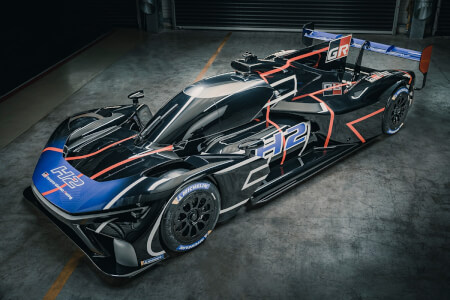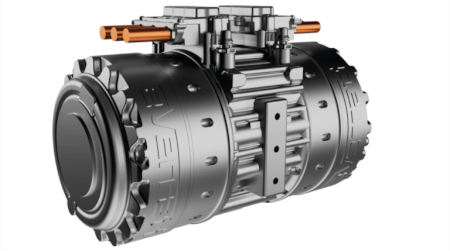September 6th 2024
Extreme H’s Pioneer 25 passes FIA crash tests
The Spark-produced Pioneer 25 car that will race in Extreme H next year has become the first hydrogen-powered racing car to pass FIA crash tests.
While the series — currently known as Extreme E — announced an indefinite pause on its 2024 season today, plans for its first hydrogen campaign next year are still progressing according to plan. Confirmation of the car passing its crash tests — centered around side impact and rollover safety — represents a major milestone in that preparation.
“The biggest news since Scotland [site of the car’s first public test run in July] is that we have undertaken and passed the mandatory chassis FIA crash tests,” Extreme H’s technical director Mark Grain told RACER. “I’m pleased to say that in both cases, the two tests in the two orientations were passed with flying colors.”
“There are some final FIA tests to undertake, but these were the two major ones. This is the big headline stuff.
“These were the ones that were making me nervous! Crash tests make everybody nervous, whatever category of racing you’re working in there. (But) they’re there for a purpose — they’re there to make the car safe.”
While other working hydrogen racing cars and rally cars have been built as technological showcases, none yet have been fully homologated for competition, making Extreme H’s successful tests all the more significant.
“We shouldn’t underestimate this. It’s the first hydrogen race car that’s passed FIA muster,” Grain pointed out. “We’ve worked with the FIA to define these crash tests, and there’s been huge collaboration with constructive conversations back and forward to arrive at the loads and speeds and so on, but, ultimately, they have defined them, and we’ve designed and built a car that’s passed them.
“Anybody can design a car and do what they want with it, it’s only when you want to start to race it and get FIA approval that you start to have to do their tests. No other hydrogen cars have gone through these crash tests like we have, so that’s a big milestone.
“Anybody else who does those will always be second now — we were the first hydrogen race car to get the FIA crash tests passed.”
With Extreme H being a one-make series, the car wasn’t developed with the need to find an edge over a rival that could potentially compromise its ability to pass crash tests comfortably. But Grain says that didn’t make the series lose focus on performance.
“We wanted to get these tests passed,” he said. “Conversely, we don’t want to be adding extra weight just for the sake of it and being too cautious. If you start adding unnecessary weight to a race car, then you’re compromising its performance. We still want the cars to be agile and to race well, so we’re very conscious of that in the design of the car.”
A major element that had to be considered, of course, was the car’s hydrogen fuel cell, with Grain reporting that everything in that regard emerged from the tests safely as well.
“The chassis itself is more rigid, it’s stronger, but we’ve added carbon composite crash structures that are sitting over the two hydrogen tanks, and also for the side impact test we’ve got composite structures either side that are energy absorbing,” he said.
“The hydrogen high-pressure and low-pressure systems were fitted (during the tests). The systems were pressurized for both for both tests, and the pressures within them were monitored as live data. That was to see if any part of the low- or the higher-pressure system had been compromised in these crash tests.
“I’m pleased to be able to say that there was no compromise to either systems, to no line, interface, junction, sensor, or the tanks. None of it was compromised or damaged in any way. In both tests, both high and low pressures were maintained, and that’s the indication that there was no damage to the hydrogen system.”
Following the completion of the crash tests, track testing of the Pioneer 25 will continue. It had been anticipated that the car would run at both Island X Prix events in Sardinia in September, but with those events now called off, the car will head back to France, where a sizable chunk of the rest of its testing to date, has been carried out.
Following the completion of the crash tests, track testing of the Pioneer 25 will continue. It had been anticipated that the car would run at both Island X Prix events in Sardinia in September, but with those events now called off, the car will head back to France, where a sizable chunk of the rest of its testing to date, has been carried out.
“We are replacing the Sardinia test with a week of testing in October,” said Grain. “We are going track testing again. It will be the equivalent to the amount of miles that we would have covered in Sardinia. We’re looking at a minimum of a three day test (and) that’s going to be in France, at a facility that we’ve used before.
“So there’s some familiarity there, which has got its advantages. Of course, we would have loved to have been running in Sardinia, because then you’ve got that back-to-back with the XE race cars, and also all the race setup infrastructure via our tech partners we don’t have at private testing — it would have been a great dry run, but we will sort that out, we’ve got work on plans to mitigate all of that.
“Luckily, we did some of that work already in Scotland, so it’s not like we’re at a complete loss. We did do some good work there with Alkamel and the telemetry systems, and (motorsport radio and communications experts) MRTC (Midlands Radiotelephone Centre). We used that time wisely in Scotland.”
While the reduction in planned races in the meantime theoretically gives Extreme H more time to complete development of the car, Grain insists no plans have changed in that regard, and it is continuing the work to the same deadlines it had when it was expecting to be racing and testing at the same time.
“The objectives of the program, the Spark team tasks and priorities and my personal workload, what we need to achieve largely remains unchanged,” Grain said. “All of those waypoints, all of those deadlines regarding Extreme H all are still valid.”
“The championship, the amount of races that we’re going to do, when the first one is, the locations and so on, people are working on that. But the worst thing we can do, from a technical and car point of view, is take our foot off the accelerator and lose the ability to go racing. If Alejandro (Agag, Extreme H founder and CEO) turns around and says, ‘I want to go racing on January 1,’ we want to be able to say, ‘Yes, we can do it.’
“It’s factual that efforts behind Extreme H haven’t lifted, and the intention is to get out there and go racing as soon as possible in 2025.”
For more information: www.racer.com
For more Industry News, please Click Here
For more information: www.racer.com
For more Industry News, please Click Here













